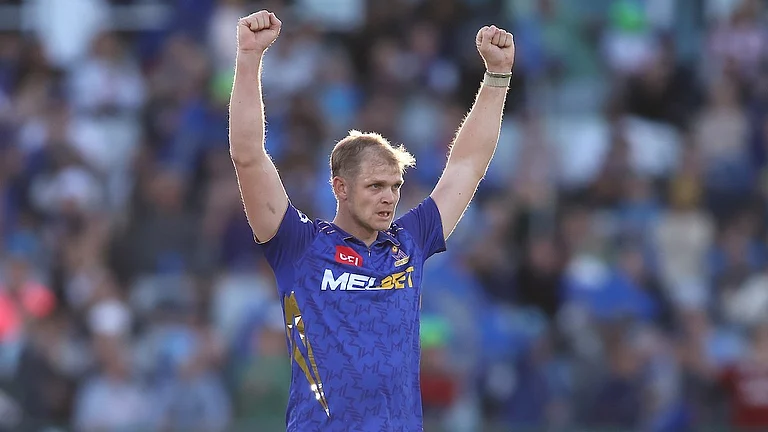This year has a bounty of India-Pakistan sporting contests. Recently, Neeraj Chopra tussled with Arshad Nadeem in the javelin final in the World Athletics Championships in Budapest. In a finish scripted in diplomacy, Chopra won gold while Nadeem won silver. Afterwards, both were as warm towards each other as they had always been.
In August, India and Pakistan met in the Asian Champions Trophy (ACT) hockey tournament in Chennai. The hosts triumphed 4-0. Considering the ACT was not the Olympics or the Asian Games, the match was free of jingoistic rhetoric.
But that will change now as javelin and hockey make way for cricket, the most popular sport in the two countries, and which stirs up more passion among the masses.
On September 2, India and Pakistan will meet in the Asia Cup in Kandy, Sri Lanka. Then there is the big one, the October 14 confrontation in the Cricket World Cup. The match is freighted with nationalistic meaning. It will be held at the Narendra Modi stadium, for one, and some flexing of saffron strength is expected.
Islamophobia does not exist as much among Indian cricketers. Not outwardly at least. For generations, Indian and Pakistani players have shared personal camaraderie. They visit each other’s homes while touring, speak the same language and appreciate each other’s skills. In a video not long ago, Javed Miandad, acknowledging Sunil Gavaskar’s greatness as a batsman, held his fingers against his temple and said, “Pehlo to Sunil Gavaskar ko... salute to you. Mai [unko] bahut bada player maanta hu.” (First of all, salute Sunil Gavaskar. I rate him very highly as a player).
A tenet of sports sledging, or of any verbal spat, is to not bring up someone’s religion. “Jaat pe nahi jana”. It is still upheld by most Indian and Pakistani players. They may otherwise fire colourful insults at each other in which family members are mentioned. But religion is not invoked.
“I personally have never even thought of discriminating against anyone over their religion. That is a very sacred and personal thing to every human being, and it should be left there,” Virat Kohli, the then India captain, said at the 2021 T20 World Cup, when his teammate Mohammed Shami was viciously trolled after India’s defeat against Pakistan.
Players have always been aware of the sensitivity of the India-Pakistan political relationship. They will never say anything that might ignite communal fires. There is the rare occasion, though, when a player slips up. This year, the Gujarat Titans bowler, Yash Dayal, shared a cartoon that was seen as Islamophobic. It showed a Muslim man consoling a Hindu girl about love jihad, while holding a dagger behind his back. Dayal later said his account was hacked and he was not responsible for the post. “I respect all communities and the picture shared today does not reveal my true beliefs,” Dayal said.
But Islamophobia is still rampant among fans. And their animosity hisses to the surface during India-Pakistan cricket matches. Many Indians want India to beat Pakistan not because they are our opponents, but because they are Pakistanis. Some of this anger is justified―given the acts of terrorism carried out by Pakistan on Indian soil―but to take it out on players is not legitimate.
That does happen, however. Fans even go after Indian players, as it happened with Shami. And when Kohli stood by Shami, fans did not spare him either, despite Kohli being a Hindu.
Shami and Kohli both put the trolls in their place. “They have no understanding of how much effort we put on the field. They have no understanding of the fact that someone like Mohammed Shami has won India ‘N’ number of matches in the last few years,” Kohli said. Shami said, “For them (the trolls), nothing is at stake because they are nobodies...we don’t need to engage with them.”
In England, Australia and South Africa, important cricketing cultures with several Muslim players, the shades of Islamophobia are different. In some ways, it is harder for Muslim cricketers there because they are more conspicuous.
“I’ve grown up as a coloured cricketer in a very white Anglo-Saxon country and a very white Anglo-Saxon cricket team,” Usman Khawaja, the Australian batsman, told The Guardian. “I stick out like a sore thumb. I don’t drink, I fast, English is my second language; my name is Usman Khawaja. When you think of an Australian cricketer you do not picture me.”
The dressing rooms in these nations can be mean too. Culturally, dressing room bullying is more of a Western tradition than Indian. The Indian dressing room has its power structures, tensions and prima donna airs, but these play out in relatively tolerable ways. In the days when the team travelled without a masseur or physio, junior players had to sometimes massage the tired limbs of seniors. They had to serve them tea or food. But these were Gurukul style rites of passage and not bullying. It is hard to imagine a player being called an “elephant washer” in an Indian dressing room, or made to sit near the toilet, the way the former Yorkshire off spinner Azeem Rafiq was at the club.
Rafiq also revealed that as a 15-year-old in the UK, he was held down and forced to drink alcohol by a fellow player. “My first incident of drinking, I was 15, I got pinned down at my local cricket club and had red wine poured down my throat,” he said.
Rafiq’s revelations of his traumatic experiences in English cricket stirred the stuffy English establishment into action. Recently, Yorkshire was fined 400,000 pounds and docked 48 county championship points for the way they treated Rafiq and their inertia to act on the racism at the club all these years.
But Western countries sometimes also display a higher commitment to inclusion. While not disregarding the struggles of Khawaja, he did make it to the Australian team after arriving on its shores at the age of four from Islamabad. Will a Caucasian or a Black immigrant ever play for India or Pakistan? It’s not impossible, but it will take time for them to be accepted by the masses.
Some outsiders are fortunate enough to find a welcoming atmosphere. Take the example of Moeen Ali, England’s mixed heritage all-rounder. In July 2017, Ali was the star of England’s win over South Africa, becoming the first England spinner to take a hat-trick in 79 years.
But Ali doesn’t drink and stayed away from the team’s champagne soaked celebrations and group picture. Captain Alastair Cook noticed this, and said to his teammates, “Make sure Moeen gets in the picture first and then we can spray afterwards.” Ali was touched and felt this was a team he would give his heart for. That’s the power of making someone feel comfortable in a setup.
Coming back to the India-Pakistan tension; its roots date back to Partition. Episodes like the 26/11 Mumbai attacks and the 2009 firing at the Sri Lanka team bus by 12 gunmen in Lahore haven’t helped. No high-profile match between the two countries has ever been free of that baggage and will never be. Sachin Tendulkar recounted in his autobiography that on his very first day in international cricket, way back in 1989, he was reminded that an India-Pakistan match is more than cricket. Just 16, he was fielding when a spectator at Karachi’s National Stadium ran onto the field, abused Kapil Dev and Manoj Prabhakar, and roughed up captain K Srikkanth.
“The political history of Partition has always cast a pall over India-Pakistan cricket and it was my first taste of this unfortunate reality,” Tendulkar wrote in his memoir, Playing It My Way.
Even India-Pakistan tours with government endorsed peace overtures, like the ‘Aman Ki Asha’ initiatives of the mid-2000s, only had a short-term and superficial impact. Wariness always lurked beneath the hugs and smiles, the kababs and the carpets. And even then, the language of conflict was never far away. At a tea party, which President Musharraf once hosted for the Indian team, he joked that the lavish spread on offer were “weapons of mass destruction”.
There was a time when Pakistan had a stranglehold over India on the cricket field, and that did breed some of India’s dislike for their neighbours. The Sharjah heartbreaks of the 1980s and a part of the 1990s left millions of Indian fans scarred. But for three decades now, India have dominated their rivals. In the ODI World Cup, for example, India are 7-0 over Pakistan. Together with India’s better performance as a nation―in matters such as economy and development― this gives Indians reason to gloat over the folks next door. And that is unlikely to change, especially if India emerge victorious against Pakistan in the Asia Cup and at the World Cup.

























